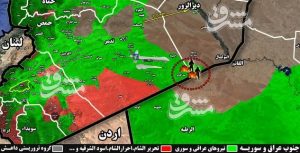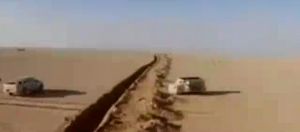Late last month, Iran’s Islamic Revolutionary Guard Corps (IRGC) publicized its drone strikes against the Islamic State near the Iraqi border in Syria. The IRGC deployed the drones as part of its revenge campaign against the Sunni jihadists, and also to show off Iran’s growing fleet of Unmanned Aerial Vehicles (UAVs).
In early August, the Islamic State raided an IRGC position near Jamouna, about 37 miles northeast of the US base in Tanf, Syria. The self-declared caliphate’s offensive led to the deaths of dozens of Iraqi militiamen fighting for the Seyyed al Shuhada Brigades. Several Iranian operatives embedded in the militia were killed as well.
Abu Bakr al Baghdadi’s loyalists captured and beheaded an Iranian officer. Photos of the dead Iranian, portrayed as a “martyr” by IRGC-affiliated sites, subsequently went viral. So the IRGC and allied Shiite jihadists vowed to exact retribution.
But first, in an attempt to cover up its embarrassing loss, the IRGC peddled a conspiracy theory saying the US struck the Iranian-led forces right before the Islamic State’s assault. The conspiracy was entirely self-serving, as the IRGC did not want to admit that Baghdadi’s goons delivered a stinging blow to its forces. [See FDD’s Long War Journal report, IRGC-controlled militia accuses US of strike to hide Islamic State raid near Syrian border.]
The IRGC wasn’t finished, however. Later in August, IRGC-affiliated websites released footage of a drone strike by the Seyyed al Shuhada Brigades against the Islamic State in Syria’s Badia desert. The footage is consistent with that of an Iranian Shahed-129 drone, according to Adam Rawnsely, an analyst who spoke with FDD’s Long War Journal. The images showed the Iraqi militiamen undertaking reconnaissance and launching a drone strike against an Islamic State technical. The footage also showed more strikes, though it was not immediately clear if they were from the same operation. That attack was just the beginning of the IRGC’s “revenge” operations against the Sunni jihadists, according to IRGC-affiliated media.
Then, on Aug. 24, Iran’s state media reported that the Iranian-led Afghan Fatemiyoun Division, backed by the IRGC’s drone unit, repelled an Islamic State assault close to Wadi al Waer, approximately 35 miles northeast of Jamouna by the Iraqi border. Footage from the drone is also consistent with that of a Shahed-129, according to Rawnsely. An IRGC-affiliated media outlet, citing “a field source,” later added that other units were positioned there and participated in the assault. They included the “resistance front’s” missile unit, Lebanese Hezbollah, Iraqi militias from the Popular Mobilization Forces (PMF) and Iranian “advisers.” While the IRGC often claims its operatives are in Syria merely as advisers, they have played a far more active role, directly leading forces in combat.
The IRGC’s drone operations against the Islamic State show how it is using multiple tactics in its irregular warfare, and directly backing its Shiite foreign legion with Iranian assets. The Islamic State demonstrated in Mosul and elsewhere that small, weaponized drones can be particularly effective in guerrilla-style warfare, even if only for a time. Iran’s UAV capability is more advanced, but is being deployed for similar ends.
The Iranian footage from eastern Syria highlighted several other noteworthy aspects of the IRGC’s battles with the so-called caliphate. IRGC-led forces dug trenches around the perimeter of their positions in an attempt to foil the Islamic State’s notoriously destructive suicide vehicle-borne improvised explosive devices (SVBIEDs). The videos included scenes acquired from the cameras of Islamic State fighters. And an Iranian reporter interviewed some of the IRGC-led militiamen following the battles, with Persian voice overs inserted into the clips.
While the IRGC claims to have killed more than 190 Islamic State combatants in the operations, it has yet to provide evidence to support this claim. The footage suggests far fewer jihadists were killed and the IRGC is known to exaggerate its enemies’ death toll.
The IRGC-led operation by Syria’s border with Iraq is part of an Iranian-Russian-Syrian offensive that aims to retake much of Deir Ezzor province. This week, pro-regime forces broke the Islamic State’s multi-year siege of Deir Ezzor city. Tehran supports the Assad regime’s territorial conquest and also wants to secure territory on both sides of the border for its own purposes.
Tehran is showing off its drones for other reasons as well. The UAVs are intended to bolster an aging, ill-equipped, and underfunded air force, thereby providing the Islamic Republic with more offensive capabilities.
Just this week, Iran’s Press TV reported that the commander of the Army Khatam al Anbiya Air Defense Base had inaugurated a new UAV base. The state media report highlighted that drones have been “playing a significant role against takfiri terrorists as well as monitoring US warships in the Persian Gulf.”
Last month, an Iranian drone buzzed a US aircraft in the Persian Gulf. Earlier in the year, the US shot down Iranian drones flying near US forces in Tanf. Iran leaked a video of one of its drones trailing an American one. An Iranian operator boasted that he could strike the US drone, even though that was a dubious claim.
Iran will continue to invest in and deploy its drones in combat and propaganda. The UAVs are contributing notably to Iran’s battles against the Islamic State, but are also intended to send a message to the US as well.
Images and videos from the IRGC-led battles against the Islamic State in eastern Syria
Footage of the IRGC-controlled Seyyed al Shuhada Brigades launching a drone strike against the Islamic State:
IRGC-affiliated media disseminated video of the Iraqi Seyyed al Shuhada Brigades launching a drone strike as “revenge” against the Islamic State for beheading an Iranian: pic.twitter.com/Csz4HSZsh1
— FDD’s Iran Project (@FDD_Iran) August 23, 2017
Iranian state media’s footage of an IRGC drone attack against Islamic State fighters:
Iran state media footage claims to show IRGC drones supporting the Afghan Fatemiyoun Division and repel ISIS in Sad al Waer, near Syria-Iraq border pic.twitter.com/59zZ3Xu2cb
— FDD’s Iran Project (@FDD_Iran) August 25, 2017
IRGC-affiliated media posted the map below showing the location of a drone strike near Wadi al Waer in August:

IRGC-led forces dug a trench that was intended to neutralize the Islamic State’s SVBIEDs:








